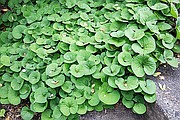Wild ginger is an ideal groundcover in the right locations
If you've ever noticed a lemony, gingery scent while tramping through shady, moist woods, you've probably stepped in a patch of wild ginger (Asarum caudatum).
Commonly found in the Pacific Northwest from California to British Columbia and east as far as western Montana, wild ginger is a lush green groundcover with 3- to 4-inch wide heart shaped, prominently veined leaves. It prefers moist woodlands below 2200-foot elevation, in soils rich with acidic humus created by fallen conifer needles.
In landscaping, deer resistant wild ginger helps control erosion, lower maintenance, suppress weeds and provide wildlife habitat. It mixes well with other shade-loving forest plants such as native ferns. In the right location, wild ginger is a strong spreader, by both seed and rhizomes, but it is not invasive. It is an excellent groundcover alternative to English ivy, which can suffocate other plants and kill trees.
Wild ginger blooms from April to mid-summer, but you have to look under the leaves to find the unusual purplish-brown, thimble-shaped flowers lying on the ground. Each blossom has three long calyx segments radiating outward resembling mouse tails. The flowers are pollinated by flies and various beetles and their seeds are dispersed by ants, attracted by oils in a fleshy appendage attached to the seed.
Unrelated to culinary ginger (Zingiber officinalis), wild ginger root is edible and was used by early settlers as a ginger substitute. It is thought to have antibiotic properties, and one study suggests that wild ginger also has antifungal properties. Native Americans used the plant for various medicinal purposes from headache to colic and as a general tonic.
You can find wild ginger growing in the moist forest habitat in the North Idaho Native Plant Arboretum. Open to the public, Arboretum parking is at 611 S. Ella Ave. or on the street.
Wild ginger is found on page 221 of the KNPS publication, "Landscaping with Native Plants in the Idaho Panhandle", available at local bookstores and the Bonner County History Museum.
Native Plant Notes are created by the Kinnikinnick Native Plant Society. To learn more about KNPS and the North Idaho Native Plant Arboretum, go online to www.nativeplantsociety.org.



